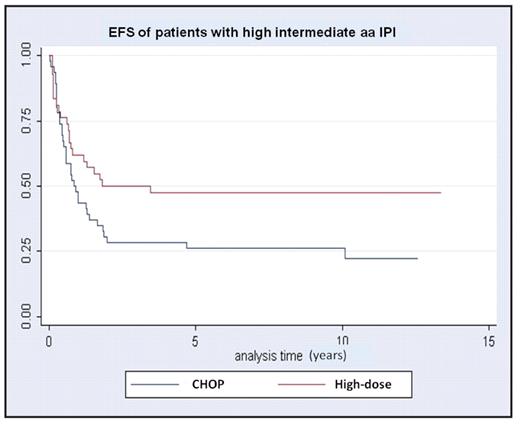Abstract
The interest of autologous stem cell transplantation upfront in aggressive non-Hodgkin’s lymphomas (NHL) remains controversial. The GOELAMS 072 was a multicenter randomized prospective trial that enrolled untreated aggressive NHL patients. It was designed to compare the interest of high-dose chemotherapy followed by autologous stem cell transplantation (auto-SCT) to the standard CHOP regimen (8 courses every 21 days). From november 1994 to december 1999, 197 patients were enrolled and randomly assigned to receive either auto-SCT (n= 98) or CHOP regimen (n=99). Because the trial has been initiated in 1994, Rituximab was not included in the therapeutic strategy. According to the aa-IPI index, 80 patients presented at diagnosis with a low intermediate and 105 with a high intermediate risk of death. The final results demonstrated that highdose chemotherapy followed by auto-SCT was superior to CHOP: the 5-year event-free survival estimates (EFS) were 55% versus 37% and the 5-year overall survival (OS) estimates for high intermediate IPI patients were 74% versus 44%, respectively.
The results of the GOELAMS 072 trial was published in the NEJM in 2004 (Milpied et al., NEJM). Second line treatment was left at the discretion of the investigators. This study reports an update of the GOELAMS 072 trial with an extended follow-up (FU) period.
All of the GOELAMS 072 pts were considered elligible for the purpose of this analysis. The primary endpoints were EFS (defined as progression, relapse or death) and OS). To date, 151 among the 197 patients have been evaluated: 77 patients were initially randomized in CHOP Arm and 74 in auto-SCT Arm. Patients characteristics at diagnosis were similar in both arms. The median FU (calculated from time of diagnosis) was 9.8 years. Fifty six events (72.2 % of the patients) have been reported in CHOP arm compared to 41 (55.4%) in the auto-SCT arm. Three patients experienced a secondary malignancy after auto-SCT compared to 4 patients after CHOP. The 9.8 year EFS and OS estimates for patients assigned to receive CHOP versus those assigned to receive auto-SCT were 45.7% vs 27% (p=0.1) and 55% vs 33% (p=0.068); respectively. Among patients with a high intermediate risk of death, the 9.8 year EFS and OS estimates were 47% vs 22% (p=0.049) and 57 vs 28% (p=0.015), respectively (see figure 1).
In conclusion, this long-term analysis (with a median FU of 9.8 years) of the GOELAMS 072 trial confirms that auto-SCT remains superior to CHOP in term of EFS and OS. In note, the advantage of an intensive strategy including auto-SCT is particulary observed for untreated aggressive NHL patients presenting with a high intermediate IPI score. Interstingly, the occurrence of a EFS plateau suggests that a subgroup of patients might be cure by auto-SCT. Because Rituximab has been shown to prolonge OS in aggressive NHL, the interest of high-dose chemotherapy plus Rituximab followed by auto-SCT compared to R-CHOP is still pending. The ongoing GOELAMS 075 prospective trial is addressing this issue.
Disclosures: No relevant conflicts of interest to declare.
Author notes
Corresponding author


This feature is available to Subscribers Only
Sign In or Create an Account Close Modal